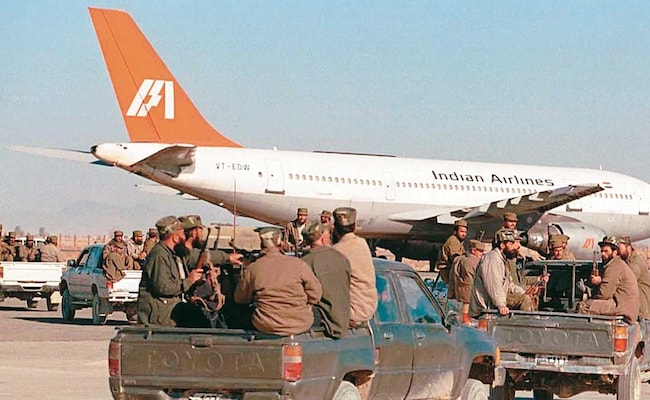Harkat ul-Mujahideen had links in the past with Osama.
At 4.53 pm on December 24, 1999, Indian Airlines’ flight IC-814 took off from Kathmandu for Delhi. A two-hour long flight lasted almost eight days when terrorists of Pakistan-based outfit Harkat-ul-Mujahideen (HuM) hijacked the Airbus A300 aircraft. The last day of the 20th century was indeed one of the most challenging for the then-Atal Bihar Vajpayee-led government.
What Were Their Demands?
The aircraft landed in Amritsar, then in Lahore, and later diverted to Dubai, finally landing in Taliban-controlled Kandahar in Afghanistan on December 25 at 8:33 am. The situation was not in India’s control and it was time for negotiation with the hijackers. A team of officials, including current National Security Adviser Ajit Doval, from relevant ministries were sent to Afghanistan to negotiate.
Then-Foreign Minister Jaswant Singh, in the Lok Sabha, gave details of what the terrorists wanted and how negotiations were carried out. Mr Singh said, “The Taliban advised the hijackers to give their full demands whereupon the hijackers demanded the release of 36 terrorists in our custody, the coffin of a dead terrorist, Sajjad Afghani, and a sum of US $200 million.”
The minister made the demands public and the Taliban advised the hijackers that demands for money and the coffin of Sajjad Afghani were un-Islamic. They changed the deal and insisted that Masood Azhar be released in exchange for 15 hostages, a demand which was again rejected by the negotiators.
But before their final demands, Mr Singh said, “The first formal demand made by the hijackers to our officials in Kandahar was the release of terrorist Masood Azhar in exchange for the release of 10 Indians and 5 foreign hostages. This piecemeal approach was rejected by the Government. Both the Taliban and the hijackers were informed that until there was a full and unambiguous detailing of demands, there could be no talks.”
Who Was Sajjad Afghani?
Sajjad Afghani was the commander-in-chief of Harkat ul-Ansar who was killed during a jailbreak attempt in the high-security Kot Balwal Jail in Jammu in July 1999. Afghani along with other terrorists had dug a 23-foot tunnel inside a cell, a few more feet and they would’ve escaped but the prison guards managed to catch them and Afghani was killed in a clash.
Interestingly, Masood Azhar was the general secretary of Harkat ul-Ansar. Afghani and Azhar were arrested in 1994. Both were in the same barracks from 1997 in Kot Balwal Jail in Jammu after Azhar was shifted from Tihar Jail in Delhi to Jammu. His body was taken by the police to Gujjar Nagar in Jammu and locals buried him in the main graveyard.
Why did he matter?
Harkat ul-Ansar was formed by the merger of two Pakistan-based terror outfits, Harkat ul-Jihad al-Islami and Harkat ul-Mujahedin. The merger of the two groups was part of the Afghan Jihad. It happened at a time when a civil war broke out in Afghanistan following the withdrawal of the Soviets and radical Islamist groups wanted to gain power.
The group found success in Jammu and Kashmir and Sajjad Afghani played a central role in its operations. Reports say around 60% of its 1,000-strong cadre were Pakistani and Afghans. The Indian Armed Forces in J&K succeeded in capturing its top leaders – Maulana Masood Azhar Alvi, Sajjad Afghania and Nasarullah Manzoor Langaryal (Commander of Harkat ul Mujahideen).
Al-Faran kidnapped four foreigners in Delhi to bargain the release of Harkat ul-Ansar leaders. But the plan failed and Delhi police arrested Ahmed Omar Saeed Sheikh, a British student of Pakistani origin who was released during the Kandahar hijack. Omar Sheikh killed The Wall Street Journal’s Daniel Pearl in 2002.
The US had put a ban on Harkat ul-Ansar for its associations with Osama bin Laden in 1997. The ban made foreign funding difficult and the outfit was renamed Harkat ul-Mujahideen. The hijackers onboard IC-814 were members of the same group.
Maulana Masood Azhar, Mushtaq Zargar and Omar Sheikh were released from jail to secure the passengers onboard IC-814. Masood Azhar, the dreaded terrorist, went on to form Jaish-e-Mohammed, the outfit behind the 2001 Parliament attack, 2016 Uri, 2019 Pulwama, 2008 Mumbai attacks and several other incidents in Jammu and Kashmir. He reportedly received funding and backing from Osama and Pakistan’s ISI. Masood Azhar was also the mentor of Omar Saeed Sheikh.
National Security Adviser Ajit Doval, who was a Special Director in the Intelligence Bureau and was part of the negotiating team said that the Indian Airlines flight IC-814 hijackers were actively supported by the ISI, adding that if they had not got support from the ISI, India could have got the hijacking vacated.
According to the officers, “one of them looked really like a mean chap”. That was Zargar, he said.
After the passengers were transferred to Jaswant Singh’s plane, they took off that very evening. Ajit Doval did not accompany them on this flight. The other officers came back to Delhi.
Kandahar was Osama’s fortress. Even though the Taliban was in power Opium and money laundering were key assets of revenue for the Taliban regime. Helmand and Kandahar, the two provinces controlled the trade and Osama Bin Laden’s Al Qaeda ran a parallel administration in the province. Harkat ul-Mujahideen had links in the past with Osama and Kandahar was a haven for the terrorists to negotiate.



